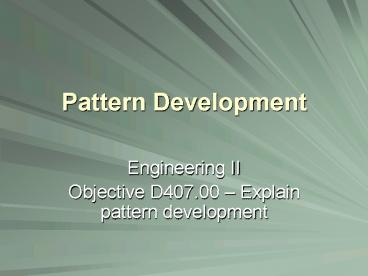Pattern Development PowerPoint PPT Presentation
1 / 18
Title: Pattern Development
1
Pattern Development
- Engineering II
- Objective D407.00 Explain pattern development
2
Where are patterns used?
- Sheet metal industry
- Packaging Industry
3
Sheet Metal Industry
- Many metal objects are made from sheet of metal
that are laid out, cut, and formed into required
shapes and fastened together. - i) Shaped by bending, folding, die stamping or
rolling. - ii) Fastened by riveting, seaming, soldering, or
welding. - Examples of surface developments from sheet metal
would be air conditioning ducts, boxes, buckets,
filing cabinets and household utensils like metal
spatulas, pot and pans.
4
Packaging Industry
- Packaging is a very large industry that uses
pattern development. - Both engineering and artistic skill are needed
when creating packages, because each package
design must meet many requirements. - i) To protect the contents during shipping of
fragile objects. - ii) Be attractive for sales appeal.
- iii) For durabilitysome packages are meant to be
used for a short time then thrown away, others
are made to last a long time.
5
Materials used in Surface Development
- Designers use many different materials and
varying thickness. - i) Thin or medium thick stock paper. This
material can be folded easily for items like
boxes others may need glue on their tabs. For
example book covers, envelopes, juice cartons
and paper cups. - ii) Cardboard, corrugated board and other
materials require an allowance for thickness. For
example boxes that have a separate cover or
boxes made of two parts that slide together. - iii) Most patterns for surface developments are
made from plastic.
6
Terms
- Pattern The development of an object that is
rolled or folded. - Surface developments -- also known as stretchouts
- Stretchout A flat pattern or development used in
laying out, cutting and folding lines on flat
stock. - Circumference The distance around a circle. The
stretchout line is equal in length to the
circumference of a cylinder.
7
Terms
- Truncated cylinder A cylinder that has the end
cut off by an inclined surface. - Parallel line development A pattern created by
drawing the edges of an object as parallel lines.
- Radial line development A pattern created by
drawing the edges of an object radiating from a
single point.
8
Cylinder
- Rectangular View
- Circular View
- Pattern View
9
Truncated Cylinder
- Top View (circular)
- Front View (rectangular)
- Truncated Pattern Development
10
Box
- This would be the pattern for a box with all
sides and including the tabs and folds.
11
Cone
- Create measuring lines that radiate from a single
point using a radial-line development typically
makes developments of pyramids and cones - The tip of a cone is called the apex.
- A cone consists of planar and single-curved
surfaces.
12
Pyramid
- Tetrahedron or Triangular Pyramid
- Oblique Pyramid
13
Elbows
- When two truncated prisms or cylinders meet at an
angle other than 180 degrees, an elbow is formed. - The type of elbow depends on the number of
surfaces you have. - For example this one has surfaces A,B,C,D
therefore it is considered a Four-piece Elbow.
14
Stretch Out Line
- The full length of a pattern when completely
unfolded is represented by the stretch-out line. - Another name given to surface developments by
industry is stretchouts.
15
Crease Lines
- The lines representing the location of folds or
bends are called crease-lines. - Crease, also called fold or bend lines, are
represented by a small circle or an X.
16
Tabs and Laps
- A tab or lap is where additional material is
added to surface developments for the purpose of
assembly.
17
Finishing techniques in pattern development
- Hemming and Seaming folding edges to make them
stiffer - Wiring process of reinforcing the open ends of
articles by enclosing a wire. Here the drafter
must add a band of material 2.5 times the
diameter of the wire
18
Types of wiring, seaming and hemming
Double flange Rolled Edge Wired
Edge Single Hem Single Flange

